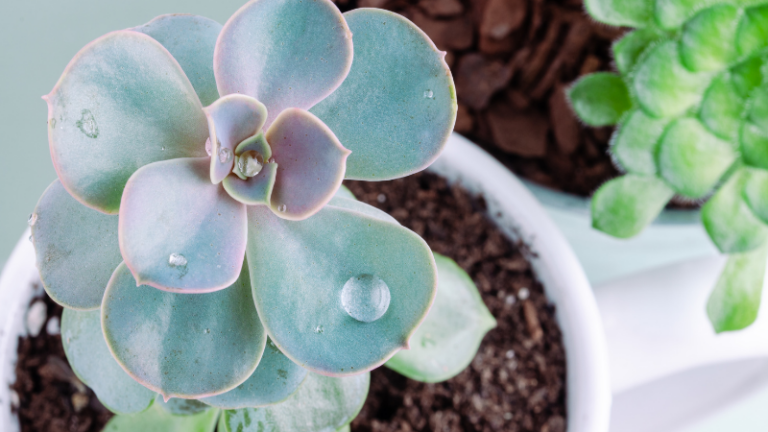Mulch is a top layer covering that aids in soil improvement, moisture retention, and weed control. Natural organic and synthetic inorganic materials can serve as the mulch.
In this article, I will explain as simply as possible what a mulch is and what its main functions are.
The various types of materials that can be used as succulent mulch
Mulch can be made from a wide variety of organic and inorganic materials. Here’s a list of some to try with your succulents. Let’s break it down into two categories:
Organic:
- Wood chips,
- Bark chips and
- Straw.
Inorganic:
- Rocks and
- Stones, such as gravel, granite, volcanic crust,
- Pebbles of various types,
- River pebbles and
- Pieces of plastic.

Contents
- The Benefits of Mulching for Succulents
- 1. It Protects The Lower Leaves From The Substrate
- 2. Prevents The Growth Of Weeds
- 3. It Allows Light To Reach The Lower Leaves And Preventing Etiolation
- 4. Reduces The Effects of Substrate Erosion And Compaction
- 5. Prevents the Substrate from Separating
- 6. It Controls The Temperature of The Substrate
- 7. Supplies Nutrients
- Where Can I Get Succulent Mulch?
The Benefits of Mulching for Succulents
If you’re looking to add some color and texture to your succulents and/or cacti, mulch is an excellent choice.
1. It Protects The Lower Leaves From The Substrate
There are fewer chances that your leaves will come into direct contact with the substrate, which could lead to the leaves rotting because they aren’t very good at coping with moisture.
2. Prevents The Growth Of Weeds
If mulch is used, weeds have a hard time growing. To keep your succulents healthy, you need to remove weeds as soon as they sprout so that they don’t compete with them for water and nutrients.
You save some time and effort by using mulch because you don’t have to deal with so many weeds.
3. It Allows Light To Reach The Lower Leaves And Preventing Etiolation
Light-colored mulches, such as white stones, reflect the sun’s rays. In order to allow the succulents to perform proper photosynthesis, this light provides a little extra illumination to the lower leaves, which are closest to the substrate.
With this, you can avoid having succulents that are etiolated Indirect light is less powerful than reflected light, so it will not burn the plant. It is absolutely risk-free.
4. Reduces The Effects of Substrate Erosion And Compaction
A good substrate must have certain characteristics in order to be useful for succulents. One of them is compaction.
The substrate is eroded and compacted over time by rainfall and watering.
In order to prevent water from reaching the substrate directly, the mulch acts as a barrier that prevents it from being contacted directly and watered more delicately by the substrate.
In tropical climates, or in general, where there is a lot of rain, this is especially noticeable.
5. Prevents the Substrate from Separating
Substrates for succulents have a variety of lighter or less dense components. Using perlite in your substrate causes it to float because it is very dense; for example, when you water it.
There will be more and more perlite showing up on the surface of your substrate as time passes, which isn’t ideal since perlite needs to be mixed with other ingredients.
You can avoid this problem by using mulch, which prevents the elements from easily soaring to the surface.
Succulents can thrive in a well-mixed substrate that retains all of the nutrients they need to thrive.
6. It Controls The Temperature of The Substrate
Mulch made of materials and colors that conduct heat poorly can help keep the substrate cooler than the surrounding environment.
It is possible for the roots of plants to be affected by the heat of the substrate exposed to direct sunlight in hot climates or during the summer.
You can protect your succulents from overheating by using the right mulch.
Contrary to the previous point, using heat-retentive materials (either by composition or color) can retain heat in the substrate.
Succulents can be protected from frost damage by using mulch as a blanket that retains heat and protects their roots.
7. Supplies Nutrients
As I discussed you can mulch your succulents with both organic and inorganic materials.
Using organic materials, like wood chips or bark chips, will decompose over time and add nutrients to the substrate, which your succulents will benefit from.
So, using mulch is not only aesthetically pleasing but also provides a number of benefits for your succulents.
Where Can I Get Succulent Mulch?
First and foremost, it is important to note that the answers to these questions vary depending on where you are in the world.
In general, you can find mulch for your succulents in gardening, construction, or pets stores.
Using fish tank stones as mulch on your succulents after cleaning them of debris and salts is also a great option A wide range of colors, shapes, and sizes are available.
Natural Cedar Shaving (Check the latest price on Amazon here) is a good option if you’re looking for an organic mulch.






